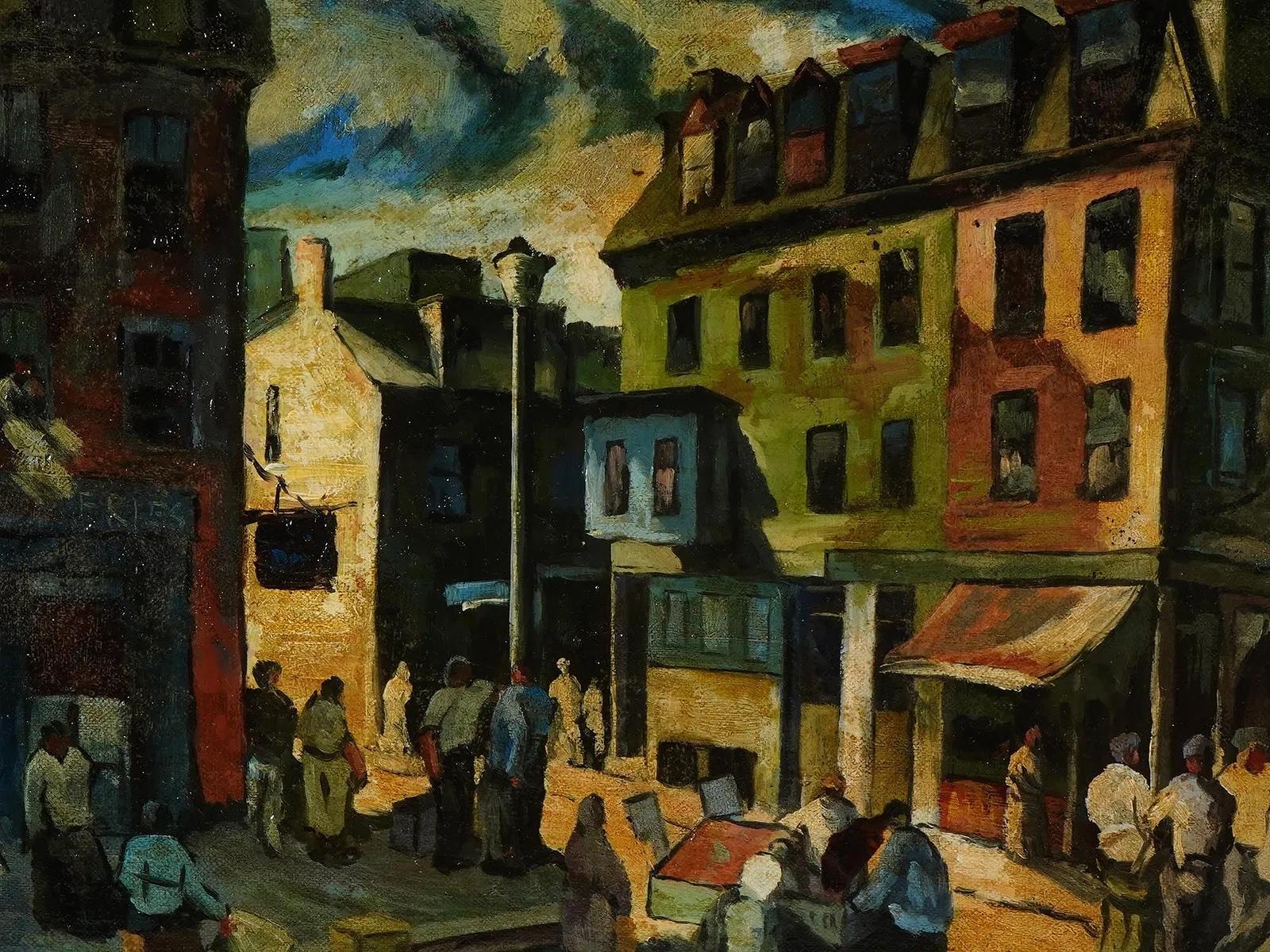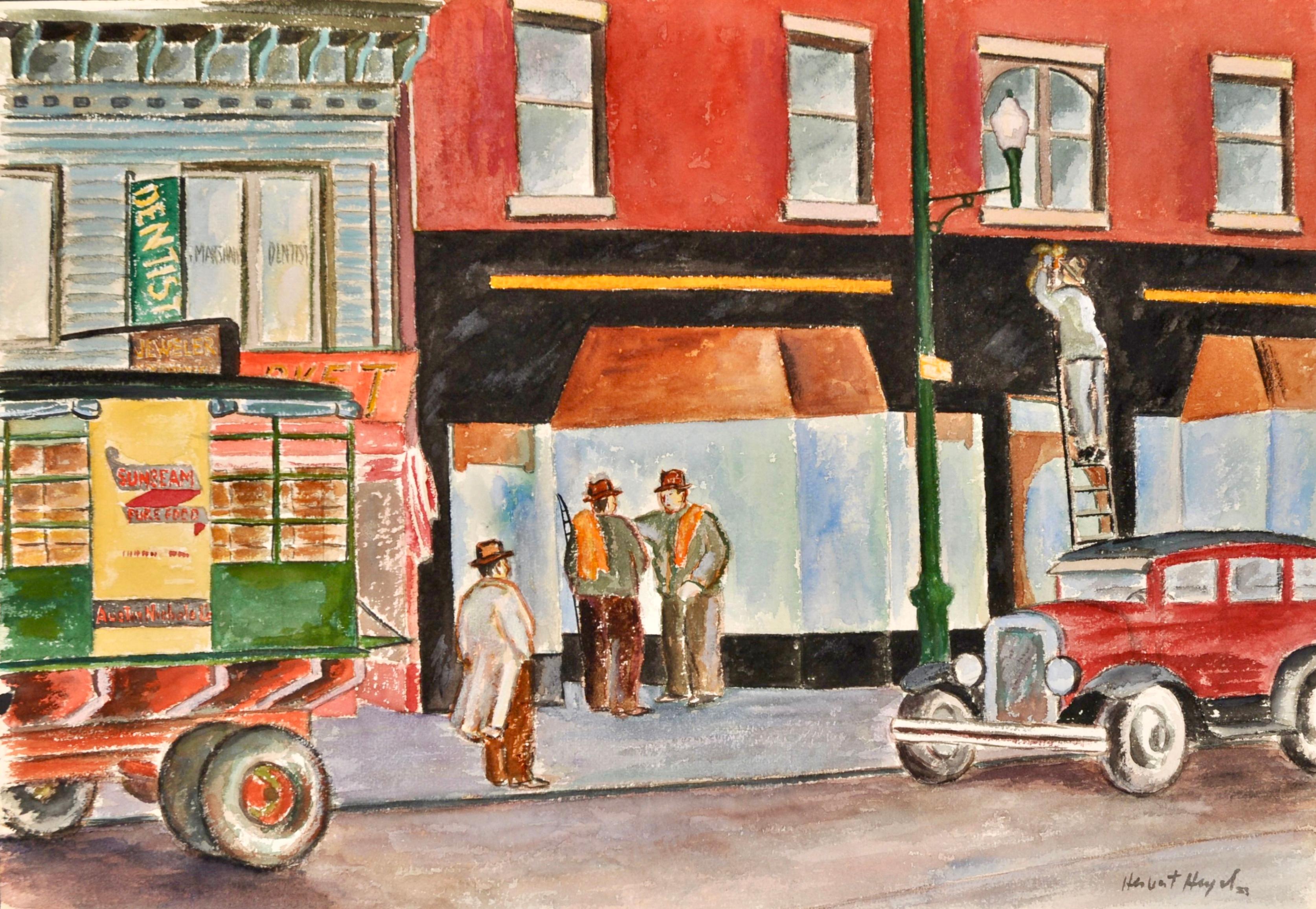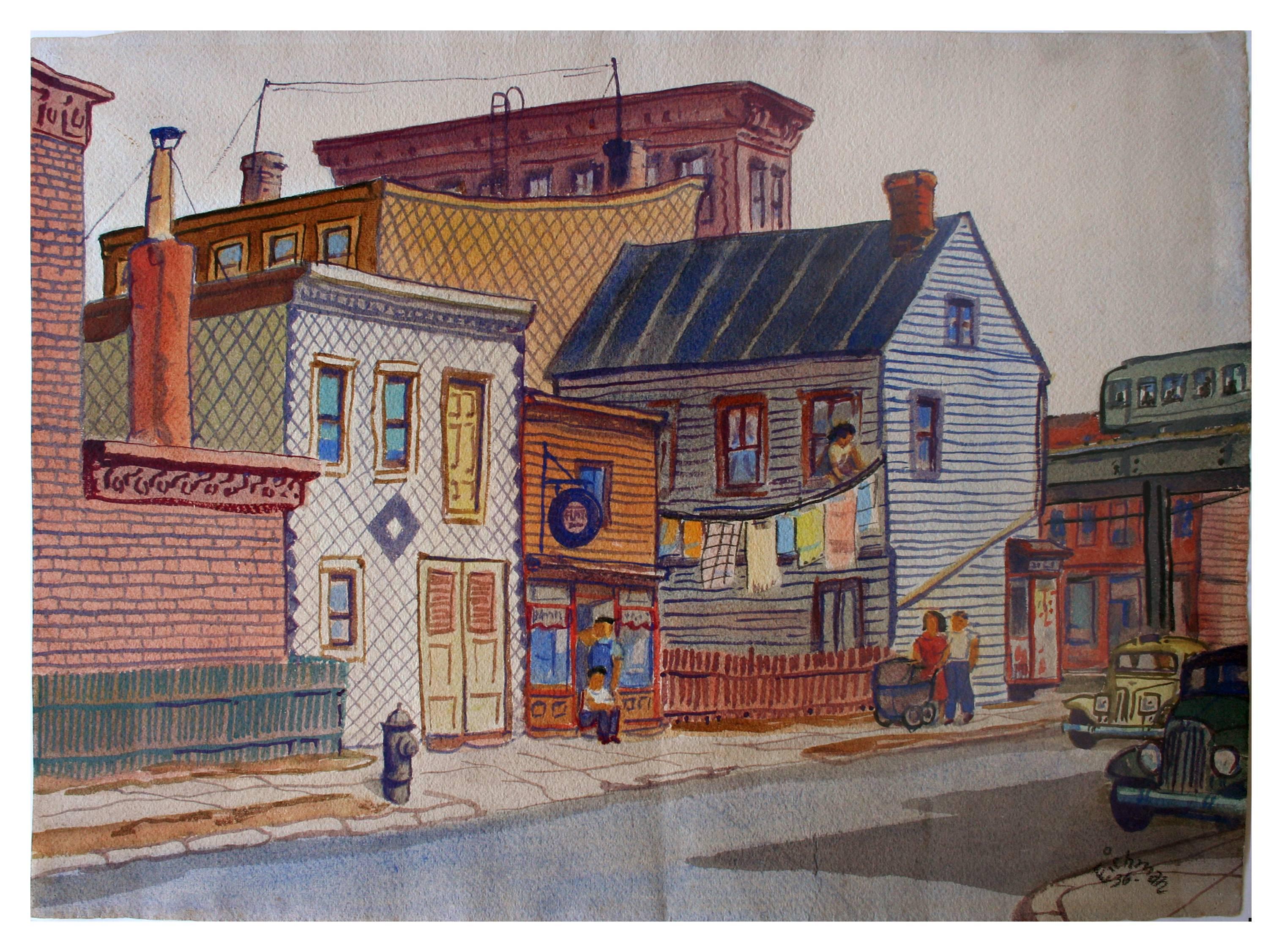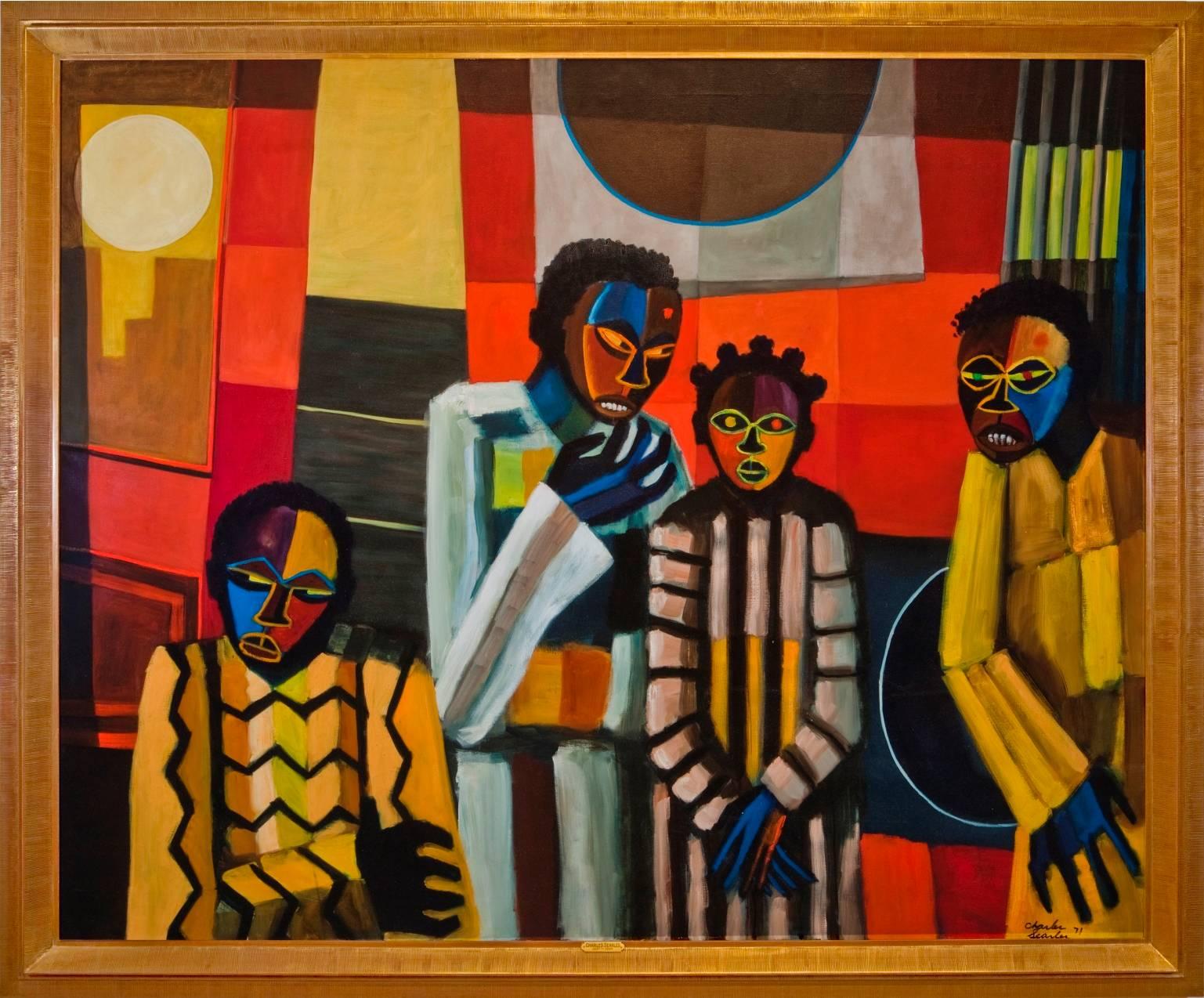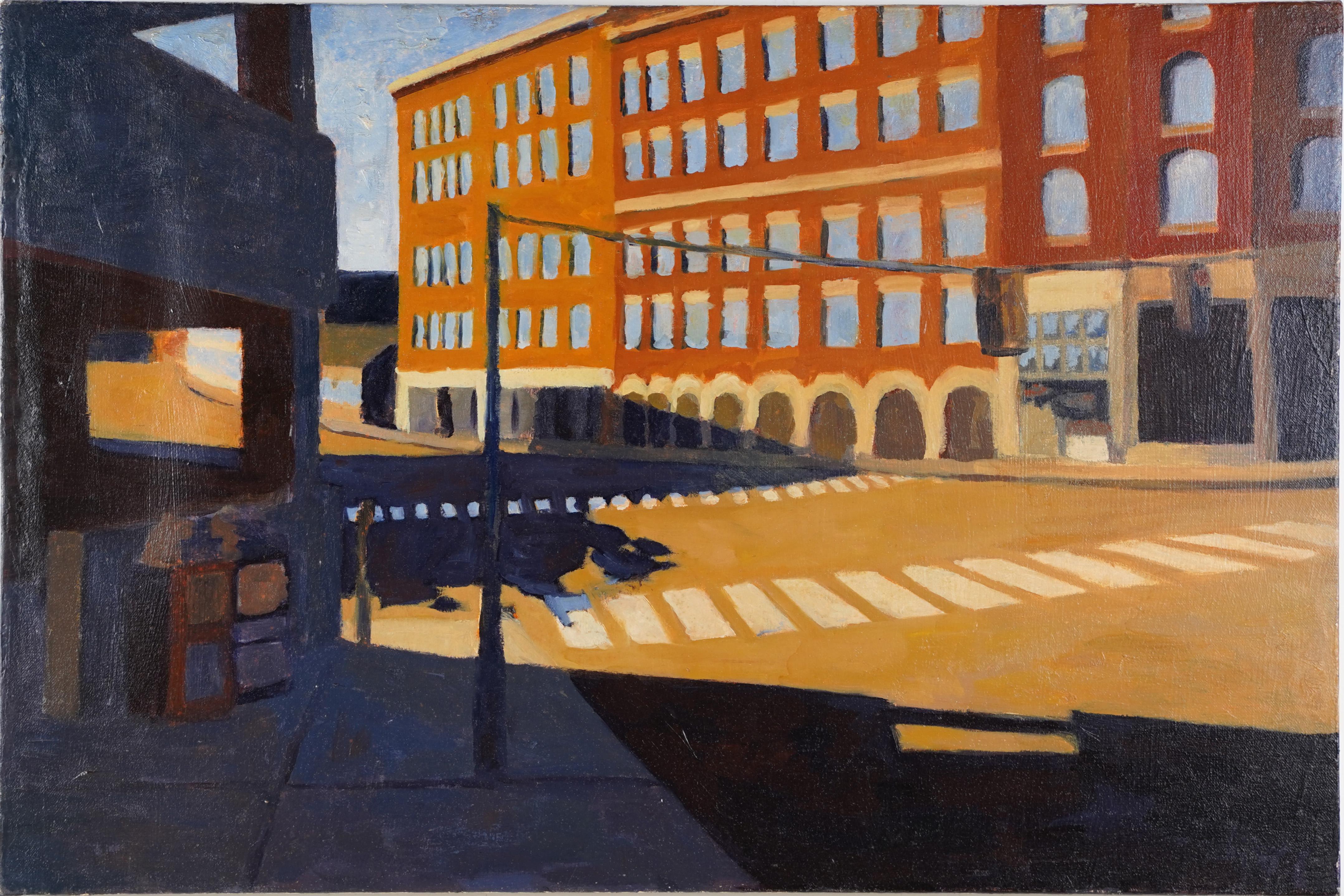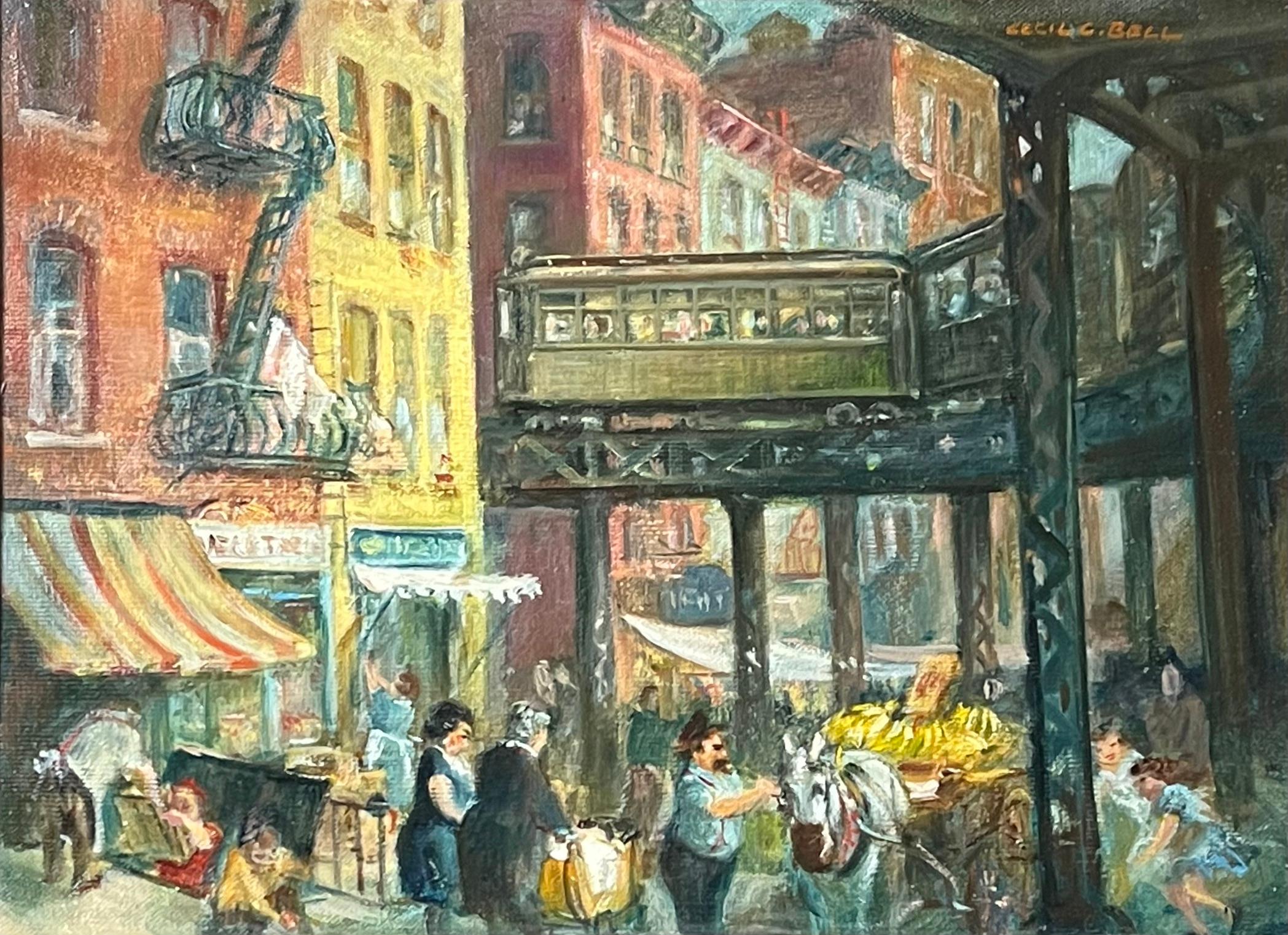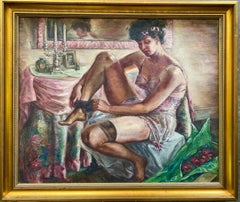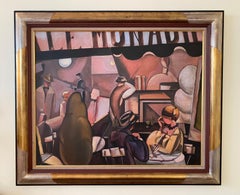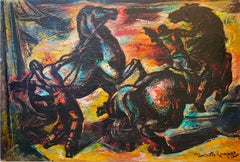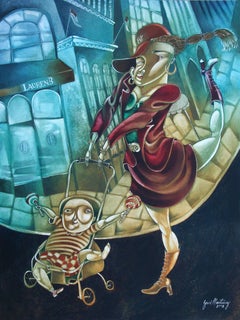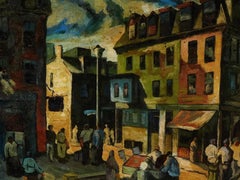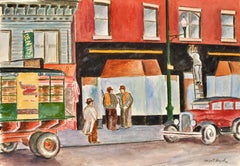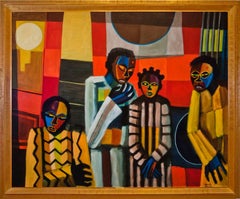Items Similar to Shopping Day
Want more images or videos?
Request additional images or videos from the seller
1 of 5
George Melville SmithShopping Day
$7,500
£5,643.05
€6,517.85
CA$10,599.46
A$11,502.03
CHF 6,095.06
MX$141,066.77
NOK 75,425.94
SEK 71,273.52
DKK 48,658.97
About the Item
>
> Painter George Melville Smith (1879-1979) Painter, illustrator born in Chicago. Smith began formal art studies at the School of the Art Institute of Chicago at the age of seventeen, after first studying as an architect's apprentice. In 1925-26 he studied in Paris under Andre Lhote, then worked as a painter in France, Spain, England and Italy. He exhibited at the Art Institute of Chicago four times during the 1930s, and was included in the Whitney Museum's 1933 exhibit which also featured Grant Wood's 'American Gothic'; his work 'Portrait of Daniel Webster Alexander' was acquired by the Whitney for their permanent collection during the same year. In 1936, he became the supervisor of 229 artists working for the applied arts project for the Works Progress Administration, a federal program during the Great Depression that aimed to make art accessible to everyone and provide work for unemployed artists.
> He was one of a handful of artists who were awarded multiple mural contracts through the Treasury Section, and was selected based upon designs he submitted to produce murals for post offices in Crown Point, IN, (1938), Elmhurst, IL, (1938), and Park Ridge, (1940). He was paid approximately $2,000 for each mural. These projects were distinct from the Federal Arts Project that was administered under the WPA in that the artists chosen did not necessarily have to be in financial need. Instead, the Treasury Section held regional and national mural competitions in order to commission 'high art' by the best artists available.The same year, Smith was commissioned to paint a mural in the lobby of the recently-constructed Elmhurst Post Office. Entitled "There Was Vision", the mural was completed in 1937 and remains installed in the Elmhurst Post Office on the east wall of the lobby. Smith was a winner of the Chicago and Vicinity Show held at the Art Institute in 1932 and also exhibited there in 1933 and 1937, as well as at the Federal Art Project exhibit that the Institute hosted in 1938. In 1933, he exhibited eight murals illustrating the history of refrigeration at the General Exhibit Building at the Century of Progress.
> He became the supervisor of the applied arts project for the WPA in 1936 and created a mural for Chicago’s Schubert Elementary School in 1938. In December 1949 and January 1950, he provided the frontispiece illustrations for Zane Grey's Western Magazine. He was a member of the Arts Club, the Chicago No-Jury Society of Artists, and in 1932 was awarded the Art Institute of Chicago's Fine Arts Building Purchase Prize, as well as a Silver Medal from the Chicago Society of Artists. He participated in the Forty-Eight States Competition in 1939, and served as the fifth president of the Chicago Society of Artists. Working in a colorful regionalist style displaying modern design elements, Smith painted both historic and contemporaneous figurative works depicting various aspects of the American Scene, as well as landscape, portraits, and still lifes. Works held: The Whitney Museum of American Art, Permanent Collection [1933]. He died in Fayette, Kentucky, on May 12, 1979.
- Creator:George Melville Smith (1879 - 1979)
- Dimensions:Height: 22 in (55.88 cm)Width: 30 in (76.2 cm)Depth: 4 in (10.16 cm)
- Medium:
- Movement & Style:
- Period:
- Condition:
- Gallery Location:Los Angeles, CA
- Reference Number:1stDibs: LU395564491
About the Seller
5.0
Vetted Professional Seller
Every seller passes strict standards for authenticity and reliability
Established in 1972
1stDibs seller since 2011
409 sales on 1stDibs
Typical response time: <1 hour
- ShippingRetrieving quote...Shipping from: Los Angeles, CA
- Return Policy
Authenticity Guarantee
In the unlikely event there’s an issue with an item’s authenticity, contact us within 1 year for a full refund. DetailsMoney-Back Guarantee
If your item is not as described, is damaged in transit, or does not arrive, contact us within 7 days for a full refund. Details24-Hour Cancellation
You have a 24-hour grace period in which to reconsider your purchase, with no questions asked.Vetted Professional Sellers
Our world-class sellers must adhere to strict standards for service and quality, maintaining the integrity of our listings.Price-Match Guarantee
If you find that a seller listed the same item for a lower price elsewhere, we’ll match it.Trusted Global Delivery
Our best-in-class carrier network provides specialized shipping options worldwide, including custom delivery.More From This Seller
View AllDressing
By Miriam Tindall Smith
Located in Los Angeles, CA
Smith studied at the School of Industrial Art in Philadelphia under Edward Warwick.
In 1935 she was asked by the Art Institute of Chicago to loan her painting, "Repose" to the forty...
Category
1950s American Modern Figurative Paintings
Materials
Oil
Au Cafe
By Francois Chabrier
Located in Los Angeles, CA
FRANCOIS CHABRIER
“”AU CAFE"
OIL ON CANVAS, SIGNED
FRANCE, C.1960
32.5 X 39.5 INCHES
Framed 41 x 48 inches.
François Chabrier
Born 1916
François Chabrier was born in 1916 in Bel...
Category
1960s Art Deco Figurative Paintings
Materials
Canvas, Oil
$4,600 Sale Price
20% Off
Horse Traners
By Umberto Romano
Located in Los Angeles, CA
UMBERTO ROMANO
"HORSE TRAINERS"
OIL ON PANEL, SIGNED
AMERICAN, DATED 1952
23.74 X 35.75 INCHES
Born: 1905 - Naples, Italy
Died: 1984 - New York C...
Category
1950s American Modern Figurative Paintings
Materials
Oil, Panel
$1,853 Sale Price
34% Off
"REGGAETON ON 47TH STREET"
By Yuri Martinez Ramos
Located in Los Angeles, CA
YURI MARTINEZ RAMOS
"REGGAETON ON 47TH STREET"
OIL ON CANVAS, SIGNED, TITLED
CUBAN-AMERICAN, DATED 2008
48 X 36 INCHES
"Reggaeton on 47th Street" is a homage to the Dominican wo...
Category
Early 2000s Surrealist Figurative Paintings
Materials
Canvas, Oil
$6,375 Sale Price
25% Off
Cubist Figures
By Irving George Lehman
Located in Los Angeles, CA
IRVING GEORGE LEHMAN
"CUBIST FIURES'
OIL ON PANEL, SIGNED
RUSSIAN-AMERICAN, C.1960
23.5 X 25.5 INCHES
FRAMED 29.5 X 32.5 INCHES
Irving George Lehman
1900-1983
Born in Kiev, R...
Category
1860s Cubist Figurative Paintings
Materials
Oil, Panel
$1,687 Sale Price
25% Off
Anita
Located in Los Angeles, CA
Attached is “Anita” (1916), by William Cahill (1878-1924), oil on artist board, 14 x 14 inches, signed & dated l/r. Exhibited at the Salmagundi Club, 1...
Category
1910s Impressionist Figurative Paintings
Materials
Oil, Panel
You May Also Like
Cityscape Mid-20th Century Modern Social Realism American Scene Regionalism WPA
Located in New York, NY
Cityscape Mid-20th Century Modern Social Realism American Scene Regionalism WPA
Samuel Thal (1903 to 1964)
"Cityscene"
12 x 16 inches
Oil on board, c. 1940s
Signed verso
Framed: 19...
Category
1940s American Modern Figurative Paintings
Materials
Board, Oil
"Streetscape" American Scene WPA Social Realism Mid 20th Century Industrial
Located in New York, NY
"Streetscape" American Scene WPA Era Social Realism Mid 20th Century Industrial
Herbert Heyel (American 1907-2000)
"Streetscape"
14 x 20 inches
Watercolor on paper, c. 1939
Signed l...
Category
1930s American Realist Landscape Drawings and Watercolors
Materials
Paper, Watercolor
Society of Six Street Scene - Figurative Abstract
By Bernard Von Eichman
Located in Soquel, CA
Stunning New York City urban modernist watercolor titled "Summer Afternoon Stroll" by Society of Six artist Bernard Von Eichman (American, 1899-1990), 1...
Category
1930s American Modern Landscape Paintings
Materials
Archival Paper, Watercolor
$6,076 Sale Price
20% Off
"In Front of the Store"
By Charles Robert Searles
Located in Lambertville, NJ
Jim’s of Lambertville is proud to offer this artwork.
Signed and dated lower right.
Illustrated in "Charles Searles" 2013 exhibition catalog (La Salle University Art Museum / Tyler School of Art) pg. 195
Charles Searles (1937-2004)
He was born in Philadelphia, PA and received his fine art education at the Pennsylvania Academy of Fine Art (PAFA) from 1969-72. He also attended the University of Pennsylvania for liberal arts studies, where he worked in the labs beside the scientists and engineers creating technical illustrations for text books. His early paintings embraced the tumultuous 60's and also reflected his own family life and surroundings.
Before graduating the PAFA, Searles received the Cresson Memorial Traveling Scholarship, and the following year, the Ware Memorial Traveling Scholarship. He was the first student to use these funds to travel to Africa. His travels in Africa marked his life and work forever -- the life, the rhythms, the patterns, and the energy.
Searles returned to Philadelphia and began teaching at the Ile Ife Cultural Center. It was then that he began his "Dancer" Series. This series marked a change in his life, celebrating his new sense of renewal and the African experience. He was awarded his first mural commission at the William G. Green Federal Building. This work, entitled "Celebration" is still on view today. At that time, he was also hired as a drawing teacher at the (then) Philadelphia College of Art, where he remained a professor for over twenty years.
In 1978, Searles moved to New York City. He found a large, raw space -- an old sewing factory -- on Broadway and Bleeker where he would remain for the rest of his life. He continued to commute to Philadelphia teaching part time. He met Kathleen Spicer, an art student, in 1983. They married in 1985. Together, they shared a wonderful, open, artistic, social, and creative experience.
Searles gradually moved away from painting and into sculpture. His sculptures maintained the vibrant color and patterns from his paintings, but seemed to dance in three dimensions. These new works embodied a live sense of rhythm and energy -- trademarks that he maintained throughout his career, whether in wood, bronze, or aluminum.
In his lifetime, Charles Searles participated in over 60 group shows, and 25 solo exhibitions. He was represented by the Sande Webster Gallery in Philadelphia for over 20 years. His paintings and sculptures can be found in innumerable public and private collections. Public commissions include the Delaware River Port Authority, the NYC Mass Transit Authority, the First District Plaza in Philadelphia, and the Amtrak station in Newark, NJ. He was the recipient of many awards, including ones from the Pollock-Krasner Foundation, the Adolph and Esther Gottleib Foundation, the Creative Arts Project Fellowship, and the National Endowment for the Arts.
His wife of 23 years, Kathleen Spicer adds: "Charles was his work, and his work was him. Inseparable. Our lives were all about art. We lived each day as if it was a gift. To me, he was enchanted. His vision was clear -- he could envision something and make it come to life as easy as breathing. Genius. Charles made the world a better place. Charles speaks loud and clear."
Bio courtesy of Kathleen Spicer (Searles)
Selected Periodical Citations:
Newhall, Edith, "Dual Celebration of Self-expression", Philadelphia Enquirer, May 2013
Fabbri, Anne, "A Farewell to Charles Searles", Art Matters, January 2005
Cornell University Review, August 2000
O'Neill, Denise I., "Black Experience Puts Soul Into the Heart of Christmas", Chicago Sun-Times, December 1996
Gleuck, Grace, Review, The New York Times, December 1996
McBride, Octavia, "An Artist Acclaimed", Philadelphia Tribune, April 1993
Fox, Catherine, "National Black Arts Festival Program Guide", The Atlanta Journal, July 1990
Wilson, William, "Black Artists in Tune with Ancestors", Los Angeles Times, January 1990
Jamusch, Ann, "Special Show-Legacy of Black Art", Dallas Times Herald, January 1990
Binkley, Barbara, "Colors, Bright and Bold", The Daily News, April 1986
Grafly, Dorothy, "Charles Searles at Neumans", ART in Focus, Summer 1978
Crittendon, Denise, "Back Home from Nigeria", The Michigan Chronicle, December 1977
Garrett, Bob, Art Section Review. Boston Sunday Herald, November 1975
Patry, Louise, "A Jubilee of Afro-American Art in Boston", New England Journal, December 1975
Wright, Charles, "Paint Art Racist", The Village Voice, April 1971
Nelson, Nells, "Black Artists Rise Above the Tempest", Philadelphia Daily News, April 1971
Canaday, John, "Black Artist on View in Two Exhibitions", The New York Times, February 1970
Collections:
- Philadelphia Museum of Art
- The Woodmere Art Museum
- Smithsonian Institute of American Art
- Pennsylvania Academy of the Fine Arts
- LaSalle University Art Museum
- Howard University Gallery of Art
- Dallas Museum of Art
- Delaware Valley Arts Alliance
- Montclair Museum of Art
- Afro-American Historical & Cultural Museum
- Museum of Afro-American History
- 35 + corporate collections
- National & international private collections
75+ Group Exhibitions, Including:
- Woodmere Art Museum
- Pennsylvania Academy of the Fine Arts
- Whitney Museum of American Art
- Museum of American Art
- Boston Museum of Fine Arts
- Brooklyn Museum
- Art Alliance
- National Afro-American Museum
- Liberty Museum
- National Blacks Fine Arts Show
- Institute of Contemporary Art
- Ackland Arts Museum
- Arnot Art Museum
30+ Solo Exhibitions, Including:
- Philadelphia Museum of Art, Philadelphia PA
- The State Museum of Pennsylvania, Harrisburg, PA
- LaSalle University, Philadelphia, PA
- Temple University, Philadelphia, PA
- Montclair Art Museum, Montclair, NJ
- Noyes Museum, Oceanville, NJ
- Delaware Valley Arts Alliance, Narrowsburg, NY
- North Carolina State University
- Winston Salem State University, Winston Salem, NC
- G.R. N’Namdi Gallery, New York, NY
- Sande Webster Gallery, Philadelphia, PA
- June Kelly Gallery, New York, NY
- Noel Gallery, Charlotte, NC
- Malcolm Brown...
Category
1970s American Modern Figurative Paintings
Materials
Canvas, Oil
Antique American Modernist Street Scene Vintage Original Oil Painting
Located in Buffalo, NY
Vintage American school modernist cityscape painting. Oil on canvas, wrapped to board. No signature found.
Category
1950s Modern Landscape Paintings
Materials
Canvas, Oil
$1,356 Sale Price
20% Off
NYC EL American Scene Social Realism Mid 20th Century Modern WPA Era Figurative
By Cecil Crosley Bell
Located in New York, NY
NYC EL American Scene Social Realism Mid 20th Century Modern WPA Era Figurative
Cecil Bell (1906 – 1970)
Street Life Under the EL
22 x 30 inches
Oil on canvas, c. 1930s
Signed upper...
Category
1930s American Realist Landscape Paintings
Materials
Canvas, Oil
More Ways To Browse
American Gothic
Grant Wood American Gothic
Raggedy Ann Doll
Red Riding Hood Painting
Restaurant Scenes Oil Paintings
Rolls Royce Painting
Royal Board Paintings
Sarah Blakeslee
Segantini Giovanni
Sertap Yegin
Signed Joyce Painting
Thos Moser
Used Wooden Rowboats
Van Dell
Vera Mukhina
Viking Painting
Vintage Cowgirl Art
Vintage Pin Up Calendars
